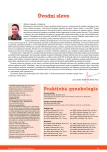Chemotherapy-induced premature ovarian failure.
Authors:
Veronika Ťápalová 1; Martin Huser 1; A. Janíková 2; L. Šmar 2
Authors‘ workplace:
Gynekologicko-porodnická klinika
LF MU a FN Brno
1; Interní hemato-onkologická klinika
LF MU a FN Brno
2
Published in:
Prakt Gyn 2010; 14(2): 89-92
Category:
Case Report
Overview
Introduction:
Premature ovarian failure (POF) is defined as an exhaustion of ovarian function before the age of 40. Hormonal substitution is the principal approach to POF treatment. To achieve pregnancy, in vitro fertilization is required using donated oocytes. Ovarian damage induced by oncology treatment is among the most frequent causes of POF. Material and methods: Oogonia are being formed during antenatal genesis of the fetus from the entoderm of the vitelline sac. Oogonia migrate to the genital ridge, develop by mitosis and, together with follicular cells, create the so-called primordial and primary follicles. Their numbers progressively decrease to 700 000 at birth by the mechanism of atresia. Exponential atresia of the follicles continues after the birth until the menopause, when all the follicles have been spent. Oncology treatment, especially chemotherapy, significantly accelerates the process of atresia and causes POF. The paper presents a case of 28-year old woman suffering from POF due to chemotherapy of the Hodgkin’s lymphoma (HL) who became pregnant spontaneously during hormonal substitution treatment. Case report: A young woman was diagnosed with HL in September 2006. The condition was identified at the clinical stage IIB and treated with 4 cycles of ABVD chemotherapy. During chemotherapy, the patient was treated with gonadoliberine analogues (GnRH-a) to prevent development of POF. After the oncology treatment had been terminated, menstrual cycle was restored and the patient had no symptoms of POF. HL relapse (state IVB) after nearly a year (August 2007) required treatment with myeloablative chemotherapy, whole body irradiation and bone marrow transplantation (BMT). This treatment resulted in POF despite supportive concomitant treatment with GnRH-a. The patient was treated with combined hormonal replacement therapy from May 2008. Two years after the second line oncology treatment, the patient became pregnant spontaneously. Considering the anamnesis of her own 2 healthy children, she decided to undergo termination of her pregnancy. Discussion: Chemotherapy accelerates atresia of the ovarian follicles. The exact mechanism of its gonadotoxic effect is unknown. POF develops due to the loss of all ovarian follicles containing fetal cells and the likelihood of spontaneous conception is very low. Animal studies have demonstrated the possibility of neo-folliculogenesis of fetal cells from pluripotent bone marrow stem cells, which migrate into the ovary. The case of spontaneous conception described above contradicts the theory of predetermined number of fetal cells in woman’s ovary (numerus fixus hypothesis). Conclusion: The process of folliculogenesis and progressive atresia of ovarian follicles is not yet fully understood. Our case report demonstrates that POF induced by chemotherapy does not need to be permanent.
Key words:
infertility - premature ovarian failure - cancer - cryopreservation
Sources
1. Prokopova I, Crha I. Předčasné ovariální selhání. Prakt Gyn 2007; 11(4): 170–173.
2. Cibula D. Základy gynekologické endokrinologie. Praha: Grada Publishing 2002 : 340.
3. Crha I, Ventruba P, Žákova J et al. Survival and infertility treatment in male cancer patients after sperm banking. Fertil Steril 2009; 91(6): 2344–2348.
4. Chiarelli AM, Marrett LD, Darlington G. Early menopause and infertility in females after treatment for childhood cancer diagnosed in 1964-1988 in Ontario, Canada. Am J Epidemiol 1999; 150(3): 245–254.
5. Huser M. Ochrana reprodukčních orgánů a funkcí u žen podstupujících protinádorovou léčbu. Doktorandská disertační práce LF MU Brno 2008 : 55.
6. Rezazadeh Valojerdi M, Eftekhari-Yazdi P, Karimian L et al. Vitrification versus slow freezing gives excellent survival, post warming embryo morphology and pregnancy outcomes for human cleaved embryos. Journal of assisted reproduction and genetics 2009; 26(6): 347–354.
7. Ciotti PM, Porcu E, Notarangelo L et al. Meiotic spindle recovery is faster in vitrification of human oocytes compared to slow freezing. Fertil Seril 2009; 91(6): 2399–2407.
8. Donnez J, Squifflet J, Van Eyck AS et al. Restoration of ovarian function in orthotopically transplanted cryopreserved ovarian tissue: a pilot experience. Reprod Biomed Online 2008; 16(5): 694–704.
9. Huser M, Crha I, Ventruba P et al. Prevention of ovarian function damage by a GnRH analogue during chemotherapy in Hodgkin lymphoma patients. Hum Reprod 2008; 23(4): 863–868.
10. Faddy MJ, Gosden RG. A mathematical model of follicle dynamics in the human ovary. Hum Reprod 1995; 10(4): 770–775.
11. Check JH, Katsoff B. Successful pregnancy with spontaneous ovulation in a woman with apparent premature ovarian failure who failed to conceive despite four transfers of embryos derived from donated oocytes. Clin Exp obset Gynecol 2006; 33(1): 13–15.
12. Vital-Reyes V, Tellez-Velasco S, Chhieng D et al. Spontaneous pregnancy in a woman with premature ovarian failure: a case report. The Journal of reproductive medicine 2004; 49(12): 989–991.
13. Johnson J, Bagley J, Skaznik-Wikiel M, et al. Oocyte generation in adult mammalian ovaries by putative germ cells in bone marrow and peripheral blood. Cell 2005;122(2): 303–315.
Labels
Paediatric gynaecology Gynaecology and obstetrics Reproduction medicineArticle was published in
Practical Gynecology

2010 Issue 2
Most read in this issue
- Gynaecological surgery techniques in female to male transsexualism.
- Hormonally-active tumours in differential diagnostics of precocious puberty in girls between 1973 and 2008
- New approaches in the aesthetic surgery of female genitalia
- Type 1 and 2 diabetes and pregnancy
